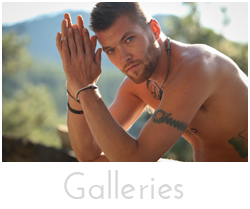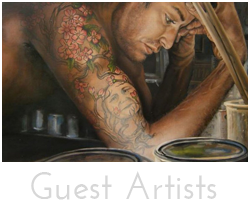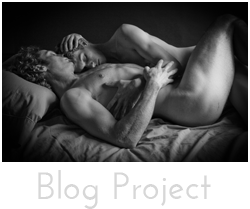JOE HENDRY - Scottish Painter and Illustrator
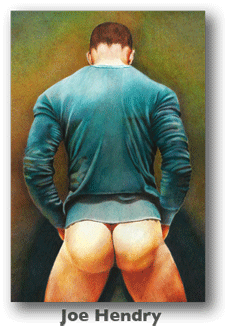 LINK TO JOE HENDRY GALLERY ON THE NAKED MAN PROJECT
LINK TO JOE HENDRY GALLERY ON THE NAKED MAN PROJECT
Joe is a Glasgow, Scotland based artist who began his professional life as an interior designerbefore starting to paint full time at the end of 2005. His artwork has been published in several art books and has been used to dress television sets including Sony Television’s “Franklin & Bash.”Having studied design in Glasgow for four years in the late eighties, following a successful career in corporate interiors, Joe decided to concentrate on what he really loved and began painting full time in January 2005.
Joe’s work seems to meander through a variety of different styles and methods, but he now concentrates mainly on figurative pieces in oil and acrylic. “I used to find attending life drawing classes really exhausting. The concentration needed was quite intense. Many of my female and male art have started off as life drawing sketches. Many others have developed from photography. We all relate to the human body and to portraiture.
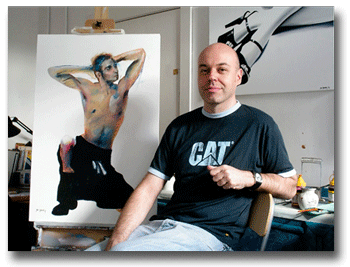 Male art or figurative male paintings and drawings have formed a substantial part of my portfolio since 2004. Creating an artwork around a male subject is interesting. I try to leave cultural preconceptions aside. This was difficult at first. I used to approach male and female figures differently. Female artwork would be soft and gentle whilst I would create male paintings, especially male nudes, in a more painterly harsh fashion. This has somewhat reversed over time. My latest males portraits and nude male drawings are created in wax and oil based media which gives a soft atmosphere to each piece. Then of course, there is the artwork featuring men wearing kilts. Being Scottish, I feel I have a right to paint kilted men. If the kilt doesn’t quite happen to be fitting properly then it just adds to artwork! I hope you enjoy browsing my Male artwork gallery.”
Male art or figurative male paintings and drawings have formed a substantial part of my portfolio since 2004. Creating an artwork around a male subject is interesting. I try to leave cultural preconceptions aside. This was difficult at first. I used to approach male and female figures differently. Female artwork would be soft and gentle whilst I would create male paintings, especially male nudes, in a more painterly harsh fashion. This has somewhat reversed over time. My latest males portraits and nude male drawings are created in wax and oil based media which gives a soft atmosphere to each piece. Then of course, there is the artwork featuring men wearing kilts. Being Scottish, I feel I have a right to paint kilted men. If the kilt doesn’t quite happen to be fitting properly then it just adds to artwork! I hope you enjoy browsing my Male artwork gallery.”
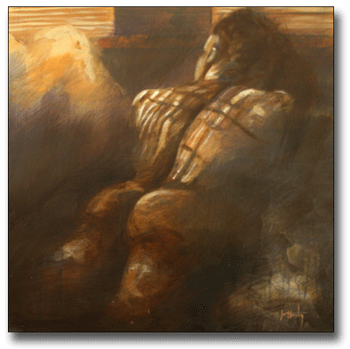 Interview with Joe Hendry:
Interview with Joe Hendry:
What draws you to create images based on the male nude form?
Drawing and painting the human form is a core part of teaching in art schools. I think it is something that never leaves an artist. It is a discipline which is much more challenging than creating a landscape painting for example. I paint both male and female figures. I used to approach them differently but I think this was due to social conditioning. I have turned my back on this idea and now paint and draw male figures in much the same way mentally as I would a female figure.
I first painted a male nude after seeing a fantastic photo on Myspace. I wrote to the guy and asked if I could use his photo to create a painting from it. Thankfully he said yes. The way the light was hitting the guys back was fantastic. It made the muscle definition evident without being excessive and I just had to try and recreate it, bringing my own emotion to the painting.
How does your work co-exist with your own sexual/sensuality? What is the personal connection?
I guess this is something that is subconscious for me. I love trying to capture masculinity in an artwork. My work is not overtly sexual. I would much rather paint a naked back and let the viewer find sensuality in that than paint what are (for me) much more obvious nudes. I connect personally to all my artwork. That is what art is all about. I am quite a private person and I don’t see my artwork as a reflection of my entire being but perhaps just aspects of it. This includes my sexuality. Unless I am having sex with someone then I don’t see my innermost thoughts as any of their business! Perhaps an artist’s work is an insight into their private self in some instances though.
What is your creative process when beginning a new piece?
There has to be an initial spark. It may be someone I’ve met or just an idea that I want to turn into an artwork. Sometimes I create a sketch but more often than not I begin straight onto canvas or paper. Rarely does what I see in my head initially resemble a finished piece. I tend to go on meandering journeys. I used to fight this but now I just allow it to happen. As a result of the way my brain works, sketches can turn into finished pieces. The artwork “Man Enough” for example started out as a simple sketch. I couldn’t stop once I had started and the sketch turned into a fully fledged artwork that took over a month.
Something else that I have noticed really affects my process is when you are spending time with a model or sitter. There is obviously a lot of time to chat. Sometimes I sketch models and sometimes I work from photographs. I began to notice that if a model had told me they were going through a tough time, this would show up in the artwork somehow. Rather than fight this, I started to embrace it.
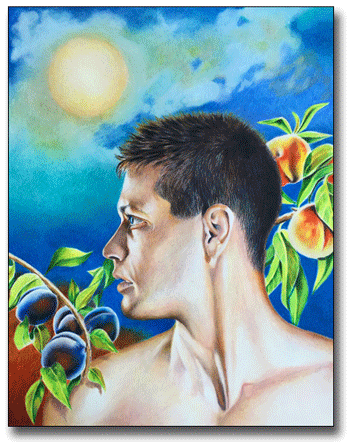 I love your ability to work is so many different styles, what was the process of the evolution of your work from one media to another?
I love your ability to work is so many different styles, what was the process of the evolution of your work from one media to another?
I think this also reflects my brain and the way it operates! Although I don’t talk about it much, I do not have a neuro-typical brain and I think is the reason for the various “styles” in the past decade. My background is in design and I think that this shows through in my early paintings. As I experimented I started to force change. However, when organic change happened, perhaps through “happy accidents” I believe this is when I had the best results.
Much of the different ways of painting and drawing are dictated by mood or a need to pacify my head and what is swirling around in my mind. I go through periods where I love to splash thick, juicy paint around or create big rough pencil marks. At the moment, I am in a much more reserved “tight” drawing phase. I embrace it all. So long as I am creating I don’t mind.
When did the move happen toward the male figure and what prompted it?
I have always drawn and painted figures. After painting a man (almost) wearing a kilt, I started to create more male artwork. I think part of this was because of the reaction. It was fascinating to hear some people describe the artwork as “cheeky” or “humorous” whilst others thought it was slightly erotic. Just because you see a naked bum (fanny to those of you in America!) it doesn’t mean it’s erotic. It all depends how an artist uses shape, depicts light and represents a subject. All these elements are important in creating the final artwork. I continued to create kilted figures for various reasons. Firstly, I am Scottish so I believe I have a birthright to do so! Also, guys in kilts look great and I love tartan.
An interesting point of note is the people who have collected nude or partially nude artwork from me, especially the semi-naked Kilties, I was once asked if it was all gay men who bought them. It certainly isn’t. I’ve had my artwork collected by gay men, women and also straight men. Some of my semi-naked male art hangs in hotel foyers. If I am bridging some gaps here then I think that is a positive thing.
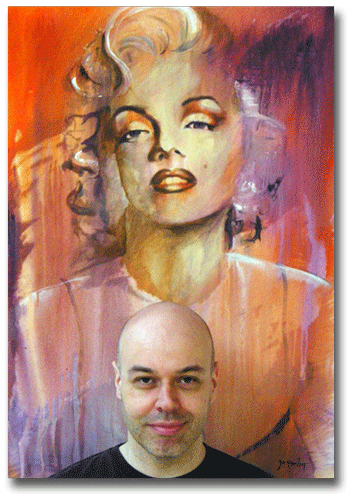 Do you find any resistance to doing this sort of work? What would you say is the greatest barrier to working on the male nude figure as an artist, if any?
Do you find any resistance to doing this sort of work? What would you say is the greatest barrier to working on the male nude figure as an artist, if any?
To answer this, I would have to say that these days I paint and draw for myself. I try not to have barriers. Once I painted two naked figures embracing for an exhibition to raise funds for HIV research. The gallery was visible from the street and the curator asked me to hide the genitals! I quickly painted a huge red cloth swirling around the figures and covering the genital area. It was very shadowed and it was not very revealing but I hid the offending body parts to comply. At the launch night I really felt that I had compromised my art. I hated what I had done and I would never do such a thing again. It is upsetting that nudity is seen so negatively. I think some of the Scandinavian countries have a much healthier attitude to the naked body. I think that it is much more disturbing that we expose our children to violence and brutality. It is absurd to think that nudity is corrupting in any way. Some people have a very strange idea of what is appropriate and what is not. It’s not like we are born clothed!
Male nude figures are more challenging to some people and I think that this is because traditionally in the western world, censorship was applied unequally for decades. It’s as if the penis is a threat to society. I believe that people who think penises are a threat to society are more of a problem.
Much of my male nude pieces don’t focus on genitals anyway, they focus on the overall person. Men can throw such great shapes. Women do too of course but in a different way.
I hope that some of my art challenges stereotypes in that some of my tough looking masculine figures are in vulnerable poses. This sometimes makes people uncomfortable but that is not a barrier for me. Anything that makes people think has to be positive.
I don’t particularly need my art to challenge people. I think that other artists are better at that than I am. It is enough for me if my artwork makes someone smile, feel a little pleasure or even just brightens their day somehow. I’ve only ever had a couple of bad experiences. One was when a gentleman was visiting my studio with his wife and told me that he thought a piece of my artwork was “absolutely disgusting”. It was a nude male figure with just a little amount of pubic hair showing near the bottom edge of the canvas. I made sure that by the time he returned with his wife to collect her commission, I had thickened the bush up quite a bit. He didn’t say a thing but as they were leaving with his wife’s landscape she said that she loved my “hairy man”. He didn’t say a thing but it was one for artist / wife nil to the homophobe!
LINK TO JOE HENDRY GALLERY ON THE NAKED MAN PROJECT
THOMAS ACEVEDO - American Painter
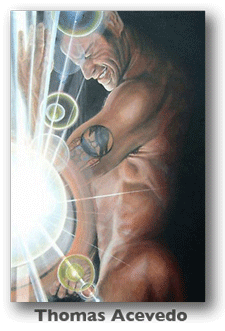 LINK TO THOMAS ACEVEDO GALLERY ON THE NAKED MAN PROJECT
LINK TO THOMAS ACEVEDO GALLERY ON THE NAKED MAN PROJECT
I first became aware of Tom's work on Red Bubble and was drawn to his image Leap of Faith. One of my personal mottos has always been “Leap and the net will appear.” So much of my life has been based on the idealism surrounding the leap of faith concept. I immediately contacted Tom and began talking to him about his images. We instantly hit it off, completely relating to what the other was creating within our own work, based on personal experiences. I have always believed that art is an expression of the soul and Tom's work stirs deep emotions within me. When I began this project, he was one of the first people I approached as a featured artist. His imagery is sexy, arousing, provocative and thought provoking. It makes us all question our own morality surrounding how we see ourselves, stripped to our barest essence; exposed, alone, isolated, dealing with identity and addiction
~ Terry Cyr, 2011
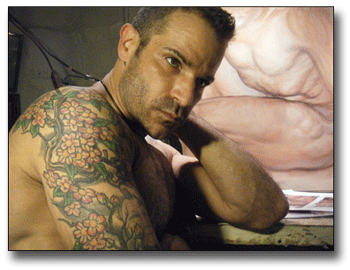 My current paintings are somewhat autobiographical, an expression of what I’m working through in my life. Breaking the Bonds was painted during one of the most difficult times in my recovery when I realized I had to let go of some of my shortcomings. Leaving Paradiseaddresses the question of why I am always looking outside of myself for something that can only be found on the inside, right where my feet are standing.
My current paintings are somewhat autobiographical, an expression of what I’m working through in my life. Breaking the Bonds was painted during one of the most difficult times in my recovery when I realized I had to let go of some of my shortcomings. Leaving Paradiseaddresses the question of why I am always looking outside of myself for something that can only be found on the inside, right where my feet are standing.
I paint because it is the only thing I know that I need to do, when my mind is not in the past or the future but in the moment. 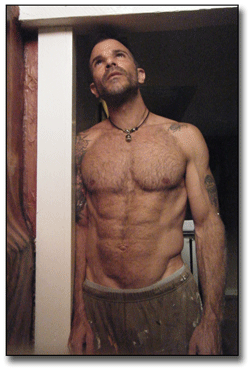 Because I feel, I paint. It is a gift bequeathed me by the Universe which, over the past twenty years, was squandered and ignored. It is only in these past two years that I have begun to paint again for myself. Painting for me is meditative, cathartic, and emotional. I truly feel I am blessed to have this venue for expression. If I can connect with even one person through my painting, I am happy.
Because I feel, I paint. It is a gift bequeathed me by the Universe which, over the past twenty years, was squandered and ignored. It is only in these past two years that I have begun to paint again for myself. Painting for me is meditative, cathartic, and emotional. I truly feel I am blessed to have this venue for expression. If I can connect with even one person through my painting, I am happy.
All of my paintings at the moment are figurative. I love the male form and I love conveying a quiet vulnerability and masculinity at the same time. The paintings are usually a compilation of photographs that I shoot and then put together using this hand with that arm or that head. The same can be said of the concept of the paintings. They are figurative paintings but I try to transfer an emotion or a stage of my spiritual growth onto the canvas. Layer by layer, I apply acrylic house paint and glaze, building references to the emotion I am trying to express. In spite of its personal nature, my work relays a struggle with life's trials and burdens that is universally felt and understood.
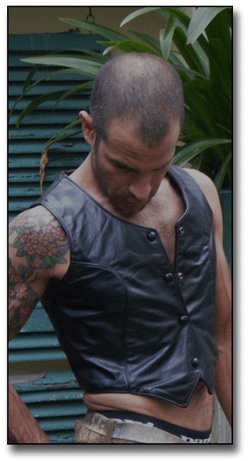 With each painting I attempt to challenge myself with lighting and with exaggerated, twisting poses that appear disturbing without being offensive. Truly I want to tell a story, to connect with the viewer. Isn't that what every artist wants? Eventually, I would like to pull back on the realism and become a bit more surreal. combining both approaches to bring the story to another level.
With each painting I attempt to challenge myself with lighting and with exaggerated, twisting poses that appear disturbing without being offensive. Truly I want to tell a story, to connect with the viewer. Isn't that what every artist wants? Eventually, I would like to pull back on the realism and become a bit more surreal. combining both approaches to bring the story to another level.
I have been a decorative painter in the New England area for twenty years – painting other people’s visions, creating decorated spaces, with paint. It has only been within this past year that I have returned to painting for the joy of it, for myself. Painting for myself on canvas has been a gift I cannot explain and don’t feel the need to. I am blessed to be able to do these paintings and work through the pain that I have insulated myself from until this year. As a result of painting for years on a large scale for viewing from a distance, I truly enjoy creating the smaller scale works. I love immersing myself in the details, savoring the time I can spend on each piece, and creating the concept. A carryover from my years as a design artist is that I still paint with regular house paint.
Link to Tom on facebook
Link to Tom's website
Link to Tom's work on Red Bubble
LINK TO THOMAS ACEVEDO GALLERY ON THE NAKED MAN PROJECT
SEBASTIAN MORENO CORONEL – Mexican/Spanish Painter
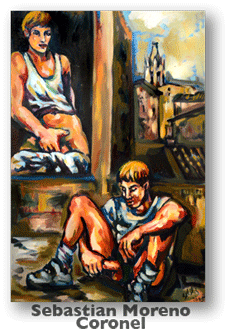 LINK TO SEBASTIAN MORENO CORONEL ON THE NAKED MAN PROJECT
LINK TO SEBASTIAN MORENO CORONEL ON THE NAKED MAN PROJECT
Sebastian is a Mexican born painter who eventually migrated to Spain. To follow his paintings is like being taken on a journey through the intimacy of his life. His work, an evolution of style, and movement of technique are personal and chronicle the ups and downs of his struggle and search for identity for love and acceptance as a gay man, as an immigrant in a foreign world, and as an artist. Extending a range of emotions from elation to desperation. Richly woven into a tapestry of myth, often filled with symbolism and subliminal meaning, a flight through bold splashes of color and stroke. It is a search for meaning and how an artist connects to the world or sometimes, in his case, disconnects from his reality. It is about love, desire, fear, failure, anger, and most import finding truth as if gazing into a mirror being held in front of him. To me he is a rare artist who expresses all his emotions, thoughts, and feelings through his art and is able to display it for the all the world to see.
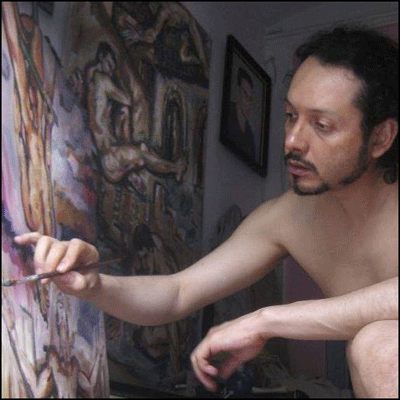
I had been aware of him, and the magnitude of his prolific body of work for a very long time, but it has not been until I recently reached out to buy one of his paintings that I really discovered him. As we began to chat, through email and on Facebook, and as I began to searched his very extensive body of work for available pieces, that I discovered we where basically on the same journey and our lives were so similar in our creative approach to self expression. The more he began to explain the meaning and feelings behind some of the work the deeper I was drawn into how truly brilliant his work and artistry was.
When I began working on this gallery and creating this biography, it just kept growing and growing. I found I could not limit my selection. I have kept it in chronological order; to be true to his evolution, through much of the more exciting work is later in the gallery. I know at first glace it seems overwhelming to see such of mass of text and imagery before you, but if you really take some time to look at each image and read the interview, I think you will discover and agree this artist is a genius. It is an intimate journal into the soul of a really great artist.
This is part of an ongoing email conversation with Sebasitan as I was reseaching his work to make it part of The Naked Man Project.
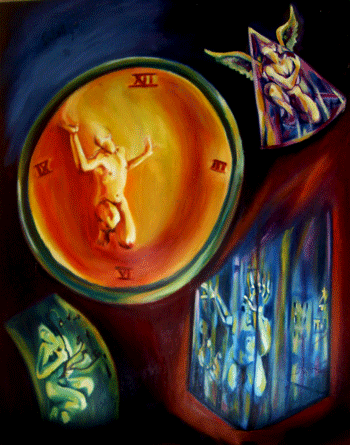 Terry: How did you begin and what where some of the things that influenced you to paint?
Terry: How did you begin and what where some of the things that influenced you to paint?
Sebastian: In 1994 I was studying Fine Arts in Guadalajara, Mexico, when I decided to make a series of paintings to do as my first solo exhibition. The series of paintings called "Sintesis en fragmentos" were influenced by the work of surrealists such as Dali or Frida Kahlo. I was then having a relationship with the first guy I fell in love with. It became a relationship filled with anguish, doubts, and cconfusion. My partner was not sure about having a man-to-man relationship, as he wanted to have children, this is reflected in my painting "Negacion de un amor". At that time thinking of marriage or having children between gay men was just a dream. In my painting called "Laberinto sin fin, laberinto sin ti", I was working with the idea of a labyrinth, I tried to paint what I felt, struggling with being a gay man, loving another, and gaining acceptance. Yet frustrated with him, as he struggles with feelings of guilt and sorrow about his sexuality, and then hiding it from others. I also painted him as a man that is inside a room with a turtle in a hand that is looking to a duck flying free out side. In "A veces este que soy" (right) I created many self-portraits, to express my feelings of living within a single moment. In it I explored four versions of my identity with time, religion, feelings and desires. One of my biggest surprises was marring a man in Spain in 2006, and having my paintings exhibited in 2009 in Jalisco the town I was born. A place I had suffered bullying and negativity as gay kid. It was a place I never imagined my work would ever be exhibited.
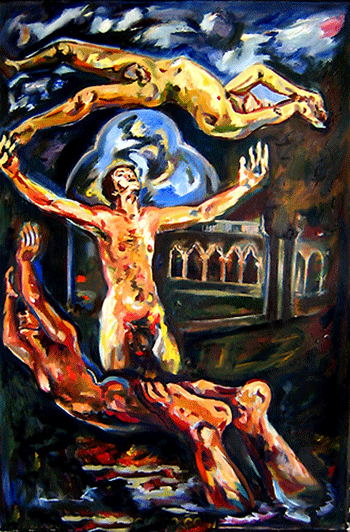 Terry: I love how autobiographical your paintings are when you describe what is behind them. I particularly think your early style is quite strong. Your compositions have a lot of energy, yet there is a soft smoothness in your strokes, unlike your current work. What is the media you used to create them? What is your process of painting or approach to a new work or piece?
Terry: I love how autobiographical your paintings are when you describe what is behind them. I particularly think your early style is quite strong. Your compositions have a lot of energy, yet there is a soft smoothness in your strokes, unlike your current work. What is the media you used to create them? What is your process of painting or approach to a new work or piece?
Sebastian: I usually paint what I am feeling because there is something happening in my life that needs to be expressed. Thanks to drawing and painting I didn't got crazy. About the smoothness in my first painting series, I tried to be realistic, and also kind of academic. But when studying at the University in Mexico City my teachers tried to help me find my own way to paint. I slowly discovered how to make my strokes, more vigorous. I also started to paint fast, and not to do more than necessary. My autobiographical approach begins in my 2001 series where I was dreaming of living in Europe. Then in 2002 the images show flight, wings and airplanes, because I was starting to travel to Europe. In 2003 the paintings combine my Mexican past and my Spanish present. In 2004 the Iraq’s War was a big concern for me and I was also without legal permission for staying here in Europe so my art reflects my anguish, and my fear about uncertainty and not feeling part of a place I could live in. In that series my painting reflects a deep depressing point in my life. "Juicio inminete" is a self-portrait of my feelings of impending doom and suicidal impulse in the painting. In 2005 my partner and I moved to our first home together. That year I painted love and expressed what it felt like being a couple. In 2006 we married and I painted a revision of myths. In 2007 I opened a shop, it was a dream to me having my own gallery, but it didn't work out well, as an economical crisis was hitting Spain. So we closed the shop in 2008. I had to recover from that and was painting in 2009 and 2010 about life and partnership. Then I started acting in cinema and also studying seriously to be an actor. Though I was still painting, I was not as active with it, since I was thinking of future and where I wanted to be.
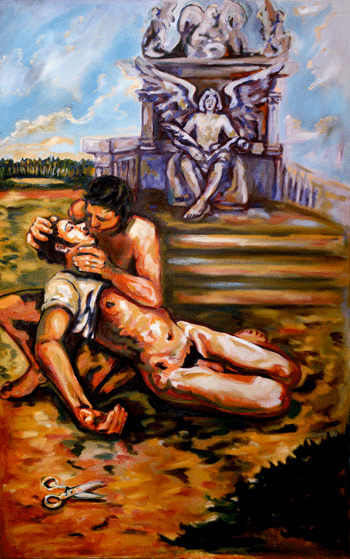 Terry: Thank you for being so open and candid in telling me about who you are. This is exactly why I began this project and what I originally meant it to become. It is the story of art and the process of creation and inner expression. When I first began photography, my instructors said shoot what you know. Much of my life was wrapped up in my sensual/sexual self and trying to express desire in a world that felt taboo, especially being from Montana. I loved the nude male and how we expose ourselves when we are reveal ourselves when we are with another and the intimacy of showing that sometimes venerable hidden parts of our selves. Montana is where I was born and it is where I chose to return. In your work I see a lot of symbols of angels or men with wings. What is the significance of these figures in your work? Can you tell me a bit more about your style during this period; it marks a dramatic break from the previous images?
Terry: Thank you for being so open and candid in telling me about who you are. This is exactly why I began this project and what I originally meant it to become. It is the story of art and the process of creation and inner expression. When I first began photography, my instructors said shoot what you know. Much of my life was wrapped up in my sensual/sexual self and trying to express desire in a world that felt taboo, especially being from Montana. I loved the nude male and how we expose ourselves when we are reveal ourselves when we are with another and the intimacy of showing that sometimes venerable hidden parts of our selves. Montana is where I was born and it is where I chose to return. In your work I see a lot of symbols of angels or men with wings. What is the significance of these figures in your work? Can you tell me a bit more about your style during this period; it marks a dramatic break from the previous images?
Sebastian: The angels or men with wings in my painting relate both to the religious symbol and also the needing of flying from uncomfortable situations. Since I was child I have always escaped the reality of situations I felt bad about; usually my mom being abused by my father who was an alcoholic or children in my school who bulled me. This is my expression of flight; in my dreams I use to float and see all from the above. In 1999 I was living in Mexico City studying at the National Academy of San Carlos. I had a teacher say my drawings were too rigid and unexpressive, so I did my best to free my hand, my brushes and the strokes to make my drawings feel alive. In the studio we had a model posing and I moved around the class to make more than one drawing, working from different perspective with each pose, while others in the class were just doing one drawing.
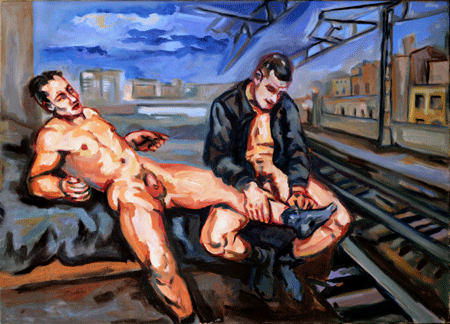 Terry: It’s almost like you have two distinctive styles from the beginning to the end. 2000 is a major shift in your work it must have been a big transition year for you. The colors become more vivid and saturated. What was happening to you during this period? What was influencing the shift? The imagery seems to becoming more allegorical.
Terry: It’s almost like you have two distinctive styles from the beginning to the end. 2000 is a major shift in your work it must have been a big transition year for you. The colors become more vivid and saturated. What was happening to you during this period? What was influencing the shift? The imagery seems to becoming more allegorical.
Sebastian: About the year 2000 painting series, I can tell you that I always wanted to come to Europe, it was just a dream that many people use to tell me it would not be possible. Actually I had a partner before I moved to Mexico City in 1997 that used to tell me that coming to Europe was almost impossible, as Mexican money here values nothing. But I kept dreaming, so when in Mexico City I had the chance to meet the man who was my partner there for 5 years before moving to Spain. He was an art critic and art historian, so he used to come to Europe for his work. And that was my chance for coming in October 1999. Visiting Greece and Italy, attending Venice Biennal, and living a dream that came true changed my way to understand art. My father died in 2000. My father was an alcoholic person that started drinking alcohol when I was 2 years or so, so I always saw him same way, being a monster at home, hitting my mom and us, lying on the street drunk, pissed, some times hurt and bleeding after falling on the street rocks. That is why I named this series "In memoriam. padre" in memory of my father. By the time I was living with my partner in Coyoacan, Mexico City, there used to be a young man lying on the neighborhood streets drunk just like my father. I used him as a model in some of the paintings in this series, like in "En guardia" "Hasta el fondo", "Entre tus manos" and "Atendido". He represents that lost life, drowned in alcohol. In these series I tried to express my way to feel about being raised in an macho education that teaches you how to be a man, and not to be a gay one, but having as an example a father who was not a real man to be inspired by. As I wanted to be anything but not a man like my father was. In these paintings sexual intercourse between men appear veiled, meaning that in a macho country gay sexuality must be hidden from others, cause it was not accepted at all.
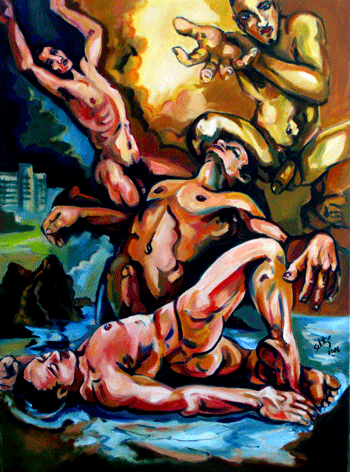 Terry: Thank you for more of the detail. My mother was also an alcoholic. When I was a child she was loving and kind, but turned to alcohol when I got older. My father used to sleep with other women and I think she knew and it was her way to get back at him, but then it consumed her and I think eventually led to all the health problems she had which eventually ended her life. She died fairly young. Your artwork has such a vibrant feel in it. I could not quite understand where that was coming from, but now that you explain it, makes more sense. It feels my own work is about searching for beauty and the extraordinary sensuality of others in the ordinary. Most of the people I photograph were just average people I met in passing and asked if I could photograph them. When they saw their own beauty it’s changed their own perception of who they were and gave them more confidence and self worth. I too used to help the less fortunate and was drawn to people homeless and on the street. So many of your images are about water and what looks like a beach. Tell me more about this period what inspires them? I also begin to see an older bearded man emerge in the work, who is this? And what is the tower?
Terry: Thank you for more of the detail. My mother was also an alcoholic. When I was a child she was loving and kind, but turned to alcohol when I got older. My father used to sleep with other women and I think she knew and it was her way to get back at him, but then it consumed her and I think eventually led to all the health problems she had which eventually ended her life. She died fairly young. Your artwork has such a vibrant feel in it. I could not quite understand where that was coming from, but now that you explain it, makes more sense. It feels my own work is about searching for beauty and the extraordinary sensuality of others in the ordinary. Most of the people I photograph were just average people I met in passing and asked if I could photograph them. When they saw their own beauty it’s changed their own perception of who they were and gave them more confidence and self worth. I too used to help the less fortunate and was drawn to people homeless and on the street. So many of your images are about water and what looks like a beach. Tell me more about this period what inspires them? I also begin to see an older bearded man emerge in the work, who is this? And what is the tower?
Sebastian: I think that art is always the searching of beauty, even in the worst situations that we experience; we always try to make our best. Of course when there is something hard to express, or something that makes us feel sorrow, pain or mad, the images will express it in another way than beauty. It's great knowing you looking for that beauty that makes life worth to be lived. I am sorry for what happened to your mom. I am sure that she was a very sensitive person who had to use alcohol trying to feel less the hard side of life. Now I understand same about my father, and thanks God cause we have art to make our life better and to express which is not the best, but avoiding drugs and alcohol, which are not the right path to follow. About water in my paintings, since 2001 when I started representing both sides of the ocean, Mexico and Europe, I called that series "Pasados recientes" meaning that something we live and enjoy is just past a moment after, and some times we try to make it live forever. That happened to me when visiting Europe for the first time in 1999, I had to keep living my reality in Mexico and didn't paint about my feeling in Europe until I came again for a second time at the end of 2000. To me water was the element that separated me from the other continent, but at a same time was the link between my country, my present reality and that recent past I have lived and enjoyed when looking to the beauty of art and life in some European countries. The first time I came to Europe I’ve said to a friend that I could happily die after visiting and looking to the beauty of Venice and other cities. But my friend said, no, you don't need to die, but live to go Europe once and again, and many times in the future. But I wanted to live here, so I started dreaming on coming and living here. That is why the paintings join images from Mexican beaches, with monuments of Europe. And those paintings talk about dreaming, and wanting to come again here.
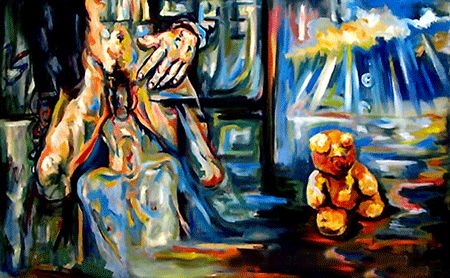 Terry: I think this is the year your work really comes to life for me. It seems stronger, bolder, more emotionally connected. Are these ideas true? So I would like to ask you, how old are you? Do you make your living through your painting? If not what else do you do to sustain yourself?
Terry: I think this is the year your work really comes to life for me. It seems stronger, bolder, more emotionally connected. Are these ideas true? So I would like to ask you, how old are you? Do you make your living through your painting? If not what else do you do to sustain yourself?
Sebastian: In 2002 I was in the last year of my Fine Art studies in Mexico City, but I had already decided to come to live in Europe. By that time I have met a man in Germany that I felt in love with and I thought he could be my partner when moving here. I also thought he could help me to find my way in Europe. But that didn't happened, so I started a relationship with the guy who is my partner since then. That year was full of emotions, as I had met the man in Germany at the end of 2001 with whom I felt in love with, then he went to Mexico to visit my country, and he also met my family and friends. So when I came to his place in Munich I was thinking on our life together. But that didn't happened because he refused supporting me as an immigrant in his country, so got totally depressed, but life gave me another chance when meeting my current partner. I started a relationship with him while in an artist residence in Spain, and eventually we got married in 2006. The painting series are called "Rutas de Vuelo" cause that year started for me in Paris celebrating under the Eiffel tower, then flying back to Mexico, after going again to Europe and back again, as in the start I was looking for a legal status to live here, but it was not easy to achieve. The painting called "Red sky over Europe" represents the death kiss, that I took from an sculpture in Poblenou Cementery of Barcelona. I made it cause I feel that death and love can be together as both sides of a coin. Eros and Tanatos. Life, death, passion, sex and pleasure is a way to feel alive, while repressing or denying our desires is kind of a death in life. Sueño en camino is a guy that is remembering his past life, wanting to grow up, and also wanting to have a partner, as a father, cause he didn't have a real one. In "Tradicion oral" (above) I play with the meaning of oral sex, and how we love it, cause it reminds us the good feelings of being fed while child. That is why a teddy bear is close that couple. I´m really happy to know you working on this gallery with such passion, as I am sure you feel many of my paintings like being yours as you got a very special sensitivity and empathy. You have been making me an interview that for sure shows the deep human feelings that I try to express when painting You asked me before if I get an income from my art. I whish I could live only from it. But right now I use to sell my paintings from time to time, which helps me to keep painting, even if for my daily expenses I get an income from my work as a massage therapist.
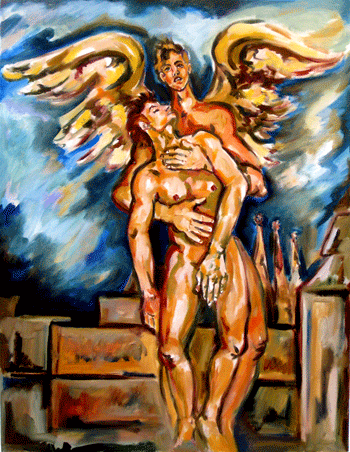 Terry: I do have some questions about what has become of your work. Have you sold most of it? Is some of it still for sale? Do you have private collectors? Any shows or places it is displayed? How have you gone about marketing it and yourself?
Terry: I do have some questions about what has become of your work. Have you sold most of it? Is some of it still for sale? Do you have private collectors? Any shows or places it is displayed? How have you gone about marketing it and yourself?
Sebastian: I started selling my work thanks to Internet in 2000. My first art collector was a friend from Boulder, Colorado. He first bought one of my paintings, and eventually collected more. Actually, most people who have bought my paintings, usually takes more than one. It has been same since then and my art is mostly in private collections in USA, Mexico, Germany, Spain, Sweden, England and France It’s has been easy selling my art works by myself. Some friends have also helped me getting to others by organizing meetings and parties at their homes to show my art. That happened to me when moving to Europe and also the first years when I was living here. I can feel very proud and grateful to them, as they have been truly important for my career. I still have many of my paintings, from my latest painting series, and also many from my starting art works for sale. Some I keep for my own collection, and others no one has asked to buy yet, but I’d be happy to sell if some one is interested in them. My art works right now are only on sale by Internet, or by asking me directly, or surfing the web. Actually I do prefer to be in touch with my collectors, to answer anything they want to know about my art, as to me price is just a symbolic value, the real value is the story behind each painting, or the vital moment I was living in when doing it. Right now selling my art is not my main income, so it can help me anytime, as it comes as a gift from my efforts or my dedication to art. I prefer it this way to keep doing my art for pleasure, not only for commercial purposes. Of course I dream of the day I would only care about enjoying life and art, and living from what I have done, but until it comes I will keep enjoying doing my art and also living from other activities.
LINK TO SEBASTIAN MORENO CORONEL ON THE NAKED MAN PROJECT
PAUL RICHMOND - American Erotic Humorist "Cheesecake" Painter
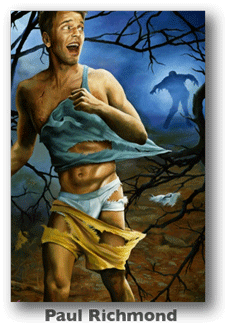 LINK TO PAUL RICHMOND GALLERY ON THE NAKED MAN PROJECT
LINK TO PAUL RICHMOND GALLERY ON THE NAKED MAN PROJECT
I first become aware of Paul’s work several years ago when I become a member of the Red Bubble site. I had just begun to show my images for the first time and was looking for others with a similar artistic bent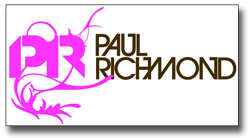 . Paul’s work immediately struck me because they were so filled with a humor I could identify with. He had developed a series he called “Cheesecake” which was a vivid throwback to the nostalgic pin up styles we had become accustomed to seeing. Typically these types of images were shown with women in these sorts of manors; for instance the old horror movie classic where the woman is being terrorized by some menacing creature. Paul seemed to somehow substitute gay men into these rolls and unknowingly, and somewhat innocently, seem to be loosing their pants. I found these sorts of images quite hysterically funny as this was the way I always wanted to dream of within my own youth. They had such a playful cartoonish edge to them that was utterly captivating.
. Paul’s work immediately struck me because they were so filled with a humor I could identify with. He had developed a series he called “Cheesecake” which was a vivid throwback to the nostalgic pin up styles we had become accustomed to seeing. Typically these types of images were shown with women in these sorts of manors; for instance the old horror movie classic where the woman is being terrorized by some menacing creature. Paul seemed to somehow substitute gay men into these rolls and unknowingly, and somewhat innocently, seem to be loosing their pants. I found these sorts of images quite hysterically funny as this was the way I always wanted to dream of within my own youth. They had such a playful cartoonish edge to them that was utterly captivating.
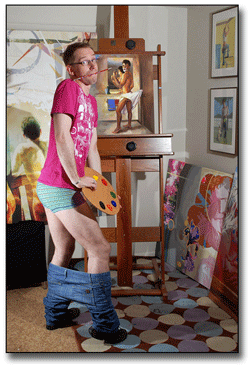 After graduating from Columbus College of Art and Design in 2002, Paul Richmond illustrated children’s books, concert merchandise, a nationally syndicated comic strip, a greeting card line, and a variety of large-scale murals. Only after coming out of the closet shortly thereafter did his fine artwork become a vehicle for exploring and understanding his own journey and developing a dialogue with other members of the LGBT community.
After graduating from Columbus College of Art and Design in 2002, Paul Richmond illustrated children’s books, concert merchandise, a nationally syndicated comic strip, a greeting card line, and a variety of large-scale murals. Only after coming out of the closet shortly thereafter did his fine artwork become a vehicle for exploring and understanding his own journey and developing a dialogue with other members of the LGBT community.
Paul describes his concept and the emergence of his style in his artist statement:
“My work is an exploration of sexuality and identity through narrative painting. I draw inspiration from my own experiences as a young gay man from a conservative environment to break down the social constructs that exist around sexual orientation and gender roles. Through colorful, illustrative, and some times humorous paintings, I expose the grey areas that become overshadowed by black and white moral codes. By employing the visual communication techniques of graphic design and illustration, my work is bold yet inviting with apparent underlying themes. It invites viewers of all origins to make personal connections with the imagery that I’ve employed to tell my story and encourages them to question conventional ideas that disregard the value of their individuality.”
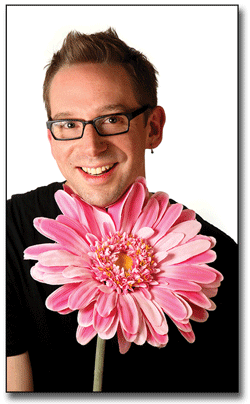
“My Cheesecake paintings put a long overdue twist on classic pin-up art. I'm interested in challenging traditional gender roles that have been reinforced by artistic expressions of sexuality in the past. It intrigues me that it was almost exclusively women who were depicted as hapless victims of skin-baring circumstance, such as the pin-up girls by Gil Elvgrin and Art Frahm. Those ladies couldn’t even walk down the street without their skirts blowing up or their underwear falling down (or both!). Meanwhile, male pin-ups by artists like Tom of Finland were generally afforded more control over their sexy shenanigans. I believe gravity and other forces conspiring to rob people of their clothing should take an equal-opportunity approach. Therefore, the models for my Cheesecake exhibit are all men; including gay male celebrities from various artistic arenas of pop culture including actor Jesse Archer, photographer Mike Ruiz, musician Ari Gold, and blogger Perez Hilton. Each figure is shown in the midst of a revealing and “accidental” wardrobe malfunction, struggling to gather his aplomb and his pants without ever losing his cool.”
Paul Richmond's paintings have been displayed at venues including the World of Wonder Gallery, A Bitchin’ Space, BoMA: The Bar of Modern Art, and the Columbus Museum of Art. His piece Remembering Tammy Faye was unveiled to celebrity guests at the late televangelist's memorial celebration, and he helped organize a successful benefit for GLBTQ youth in association with his recent solo exhibition Ins and Outs. Richmond's work can be seen in the erotic art anthology Stripped Uncensored, published by Bruno Gmünder, as well as 100 Artists of the Male Figure by Schiffer Publishing. He lives with his partner Dennis Niekro and their two whippets in Columbus, Ohio.
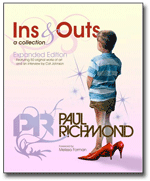 His book contains some of his most personal, narrative works arranged in chronological order by the period of his life represented. It documents the journey of a Dolly-idolizing, repressed gay boy as he finds his way out of the closet and into a place of self-acceptance. Accompanying each piece is a description by the artist, explaining the thoughts and emotions behind it. The result is an intimate, visual experience, one that will draw on the viewer to recognize the beauty of discovering and developing their own authentic self, regardless of sexual orientation.
His book contains some of his most personal, narrative works arranged in chronological order by the period of his life represented. It documents the journey of a Dolly-idolizing, repressed gay boy as he finds his way out of the closet and into a place of self-acceptance. Accompanying each piece is a description by the artist, explaining the thoughts and emotions behind it. The result is an intimate, visual experience, one that will draw on the viewer to recognize the beauty of discovering and developing their own authentic self, regardless of sexual orientation.
This expanded edition features 50 pieces of art, including Paul's Cheesecake Boys series, novel cover illustrations, and a new interview by Cat Johnson.

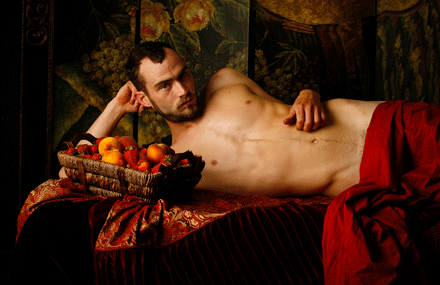












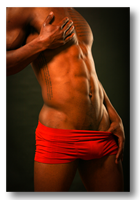
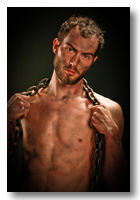
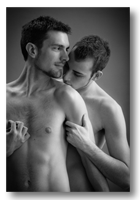
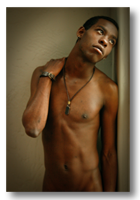
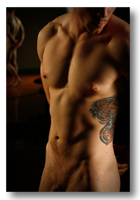
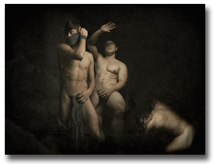
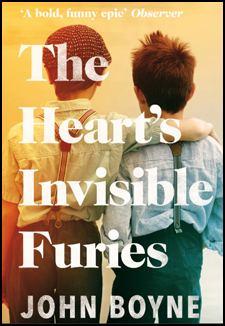 The Heart's Invisible Furies - John Boyne (Irish)
The Heart's Invisible Furies - John Boyne (Irish)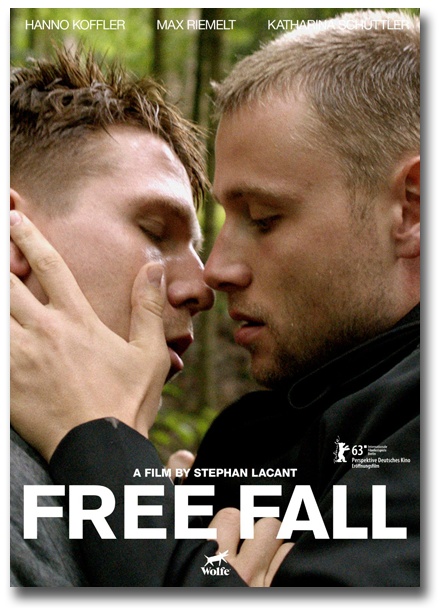 Free Fall (German)
Free Fall (German)